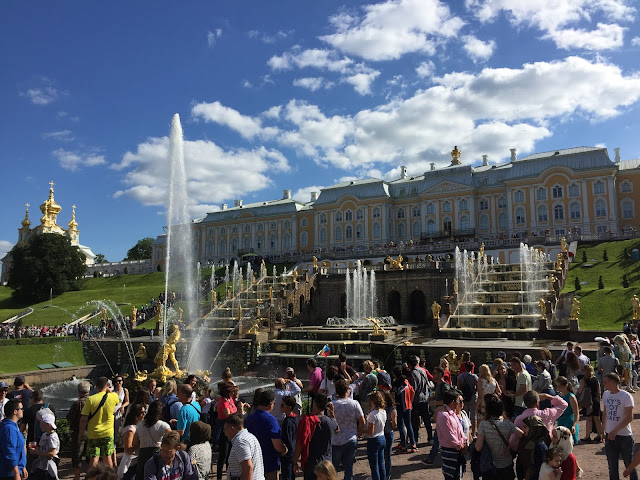88. St. Petersburg's suburban palaces #2 - Peterhof
Peterhof is considered to be among the top tourist destinations in the St. Petersburg area, and allegedly sees more visitors than anywhere else in Russia. Similar to Tsarkoye Selo, the centerpiece of Peterhof is an extravagant palace used by the tsars as a summer retreat. The palace was inspired by Peter the Great's visit to Versailles in France at the end of the 17th century, and is now referred to as "the Russian Versailles". The palace is surrounded by extensive gardens and parks as well as numerous other museums, churches, and outbuildings. There are literally dozens of things to do here, but most of them require a separate ticket so it's not only too time-consuming to see everything in a single trip from the city center to the suburbs, it's also prohibitively expensive to visit more than a few sites at a time.
After walking through Peterhof's Upper Gardens on our way back from the Petrodvorets watch factory, We decided to spend our afternoon at the two major attractions - the Lower Gardens and the palace itself. Peterhof Palace was built in the early 18th century by Peter the Great, and was expanded over the next several centuries by subsequent Russian monarchs. It was significantly damaged during the Nazi occupation of the Great Patriotic War, but was quickly rebuilt and restored to its original specifications and is now one of the three or four main stops for tourists to St. Petersburg.
After a lengthy wait in line on a Sunday afternoon the previous month at Catherine Palace, I thought we would have more luck with the crowds by visiting the even more popular Peterhof Palace on a weekday. Boy, was I mistaken. Perhaps the beautiful weather brought out more tourists than might normally be expected on a Wednesday afternoon. We spent lots of time in various queues: 15 minutes to buy tickets to the Lower Gardens, 5 minutes to get into the gardens, 1 hour 45 minutes to buy tickets to the palace (and we barely squeaked through by the 2:00 pm deadline, no thanks to the 15-20 Russian tourists who inexplicably just pushed ahead of everyone else to the front of the line), and another 30 minutes to get into the palace.
All in all, the wait was worth it - the palace is spectacular. The more-or-less mandatory group tour is offered only in the Russian language, so we just hung back and went through at our own pace. That worked fine because many of the rooms have English signage. Unfortunately, no photography is allowed inside the palace.
The Lower Gardens are perhaps the star of the show, and the most impressive I've seen here in Russia. The dozens of ornate fountains found throughout the garden date back to the 18th century, and each is different from the last. The Grand Cascade and Samson Fountain right in front of the palace get most of the attention, but there were also Italian and French fountains nearby, and matching Adam and Eve fountains, Romecal Fountains, a Dragon Cascade, and a variety of trick fountains (which were popular with children) throughout the park, in between the palace and the Gulf of Finland. The fountains run on a gravity-fed system (the original 18th century pipes have been replaced, of course) and no pumps are required. The fountains only run for 10 hours per day, between May and September.
After walking through Peterhof's Upper Gardens on our way back from the Petrodvorets watch factory, We decided to spend our afternoon at the two major attractions - the Lower Gardens and the palace itself. Peterhof Palace was built in the early 18th century by Peter the Great, and was expanded over the next several centuries by subsequent Russian monarchs. It was significantly damaged during the Nazi occupation of the Great Patriotic War, but was quickly rebuilt and restored to its original specifications and is now one of the three or four main stops for tourists to St. Petersburg.
After a lengthy wait in line on a Sunday afternoon the previous month at Catherine Palace, I thought we would have more luck with the crowds by visiting the even more popular Peterhof Palace on a weekday. Boy, was I mistaken. Perhaps the beautiful weather brought out more tourists than might normally be expected on a Wednesday afternoon. We spent lots of time in various queues: 15 minutes to buy tickets to the Lower Gardens, 5 minutes to get into the gardens, 1 hour 45 minutes to buy tickets to the palace (and we barely squeaked through by the 2:00 pm deadline, no thanks to the 15-20 Russian tourists who inexplicably just pushed ahead of everyone else to the front of the line), and another 30 minutes to get into the palace.
All in all, the wait was worth it - the palace is spectacular. The more-or-less mandatory group tour is offered only in the Russian language, so we just hung back and went through at our own pace. That worked fine because many of the rooms have English signage. Unfortunately, no photography is allowed inside the palace.
The Lower Gardens are perhaps the star of the show, and the most impressive I've seen here in Russia. The dozens of ornate fountains found throughout the garden date back to the 18th century, and each is different from the last. The Grand Cascade and Samson Fountain right in front of the palace get most of the attention, but there were also Italian and French fountains nearby, and matching Adam and Eve fountains, Romecal Fountains, a Dragon Cascade, and a variety of trick fountains (which were popular with children) throughout the park, in between the palace and the Gulf of Finland. The fountains run on a gravity-fed system (the original 18th century pipes have been replaced, of course) and no pumps are required. The fountains only run for 10 hours per day, between May and September.






















































Comments
Post a Comment